Medals relating to Awards
This page shows medals that relate to awards.
Please let me know if I missed an award-related medal that is already on this site but not part of this collection.


The medal's obverse bears Liberty walking alongside a Buffalo. Around top, PAN-AMERICAN EXPOSITION; in exergue, field for dedication.
The medal's reverse bears South-American and North-American Native Americans smoking peace pipe together, shields with representations of their respective continents at their feet. Above, BVFFALO / VSA MCMI
The Pan-American Exposition was a World's Fair held in Buffalo, New York from May 1st through November 2nd, 1901. The exposition is most remembered for the shooting of U.S. President William McKinley. Anarchist Leon Czolgosz shot him on September 6th while he was visiting the fair.
The medal exists in plain bronze, silver and gilted bronze variants. The silver variants are very rare but no mintages have been reported.
The medal measures 64mm in diameter and was manufactured by the Gorham Silver Company.
References: Baxter 106, Marqusee 250
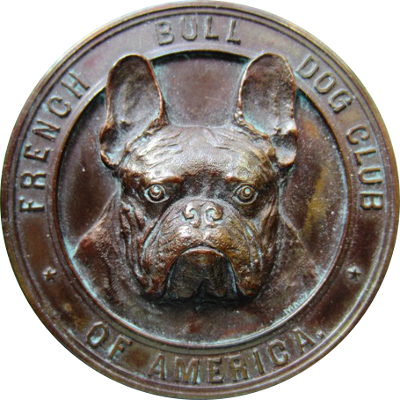
The obverse bears frontal bust of French bull dog in center field. Around, ★ FRENCH BULL DOG CLUB ★ / OF AMERICA. Signed within center field at lower right, MANZ
The first show of the FBDCA was held at the Waldorf Astoria in New York City on February 12, 1898. An image of the medal is also incorporated in the cover design for The French Bull Dog, an illustrated monthly for Gilded Age devotees of the breed that ran from 1913 and 1914. An early medal from this series was donated to the Jay Heritage Center in Rye, NY, by Joy Van Norden, daughter-in-law of Warner Montagnie Van Norden, who raised prizewinning Frenchies.
The original image of the medal came from the Jay Heritage Center Archives.
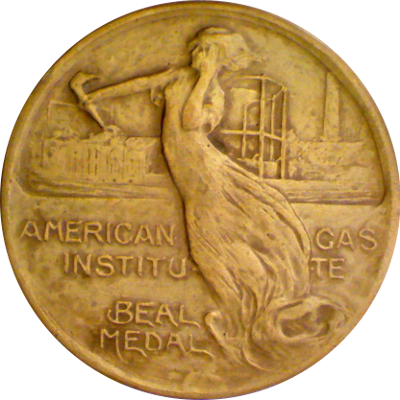
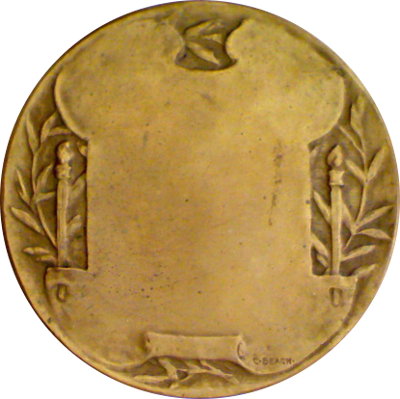
This medal's obverse bears female gas spirit rising from ground, holding burning torch; in background, modern gas refinery and storage tank. Across, AMERICAN - GAS / INSTITU - TE / BEAL / MEDAL.
The reverse shows a blank cartouche, torches and laurels. Signed at bottom right, C.BEACH.
The American Gas Institute was an amalgamation of various regional gas light companies that worked on promoting scientific research and technological development to help with the production, distribution and consumption of gas. The Beal Medal was awarded annually to the best research or invention in the Institute's areas of interest.
My copy of this medal is actually in two pieces. Both obverse and reverse are struck in thick medal stock and each has been fitted with two pins in back to hold them on a cardboard base. Apparently, the pieces came from Chester Beach's studio collection and probably represent trial strikes that the artist kept for himself.
This medal measures 50mm in diameter and was struck in bronze and silver by the Medallic Art Company of New York.
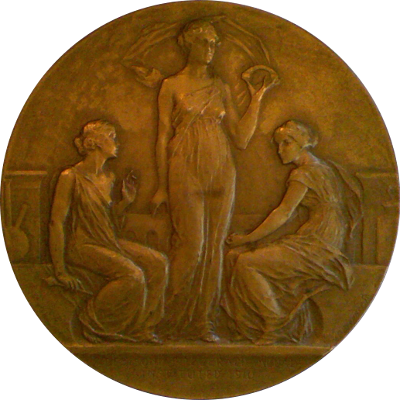
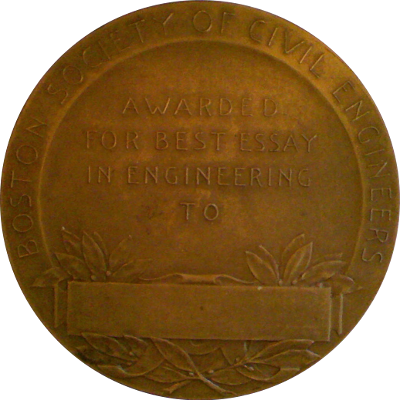
This medal's obverse bears three robed female figures, two seated ones flanking standing one in the middle. In exergue, incuse inscription: DESMOND FITZGERALD MEDAL / INSTITUTED 1910
The reverse bears laurel branches behind ninscribed cartouche at bottom. Around, BOSTON SOCIETY OF CIVIL ENGINEERS; in center field, AWARDED / FOR BEST ESSAY / IN ENGINEERING / TO
This beautiful medal was commissioned by Desmond Fitzgerald, a past President of the Society, to honor the author of the best paper published by a member of the Society during the year ending in the month of September. He donated the tidy sum of $2,000 to fund the medal. He reasoned that a medal wold be the best form for such a prize because the prize should be valued not for its intrinsic worth but solely as
"a testimonial that the holder of it has contributed something which his fellow members consider of great value to the engineering profession also that the evidence of having received such an award will be more available and less likely to be deposited where it can seldom be seen if the medal is of bronze rather than of precious metal."
The medal has a diameter of 76.3mm and was struck in bronze by the U.S. Mint. Mint records indicate that 18 pieces were struck at the order of Brenner in November of 1911.
References: Hahlo 44, 60
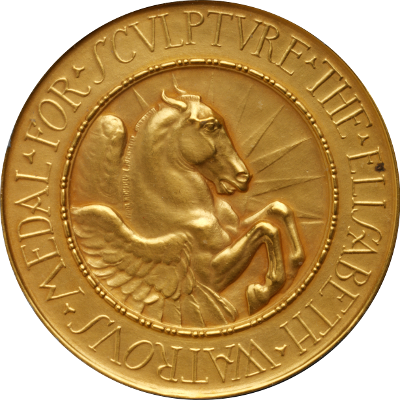
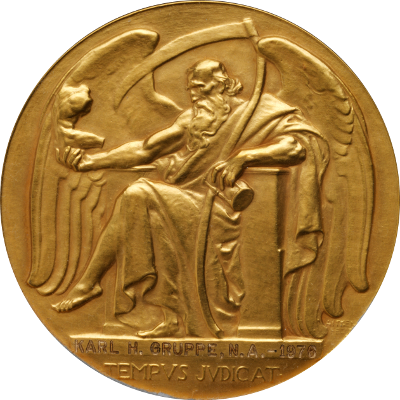
Aitken designed this medal in 1914 for the National Academy of Design. The obverse bears a rearing pegasus before a stylized sun. Around, THE ELISABETH WATROUS MEDAL FOR SCULPTURE. The reverse bears a bearded man with wings, scythe and hourglass, judging sculpture of torso held in right hand. Below, TEMPUS JUDICAT.
I might be very wrong in my interpretation, but I think that Aitken expresses that time might be the harshest critic of art and that true art not only has to win the contemporary critic's heart but has to withstand the test of time. This interpretation would fit well with his strong artistic conservativsm.
Many thanks to the library of Cornell University which has allowed me to use their high quality image of this medal with the following notice:
Gift of Muriel Doebler-Glaser
Photography courtesy of the Herbert F. Johnson Museum of Art, Cornell University.
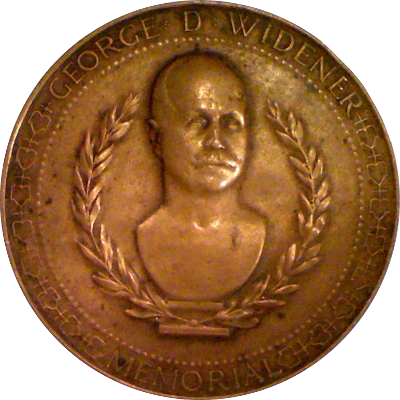
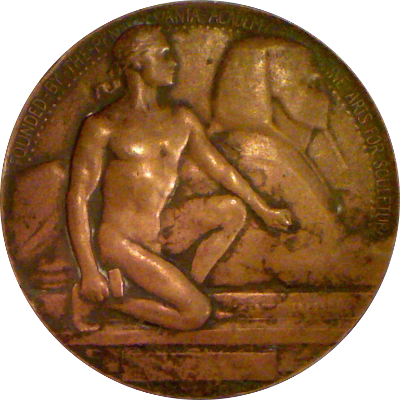
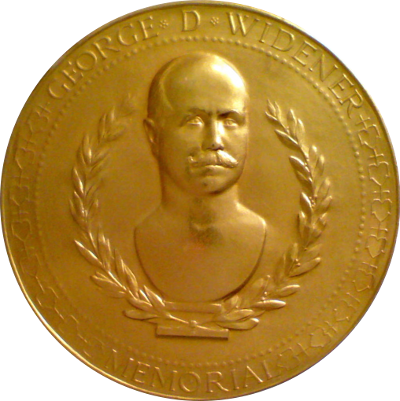
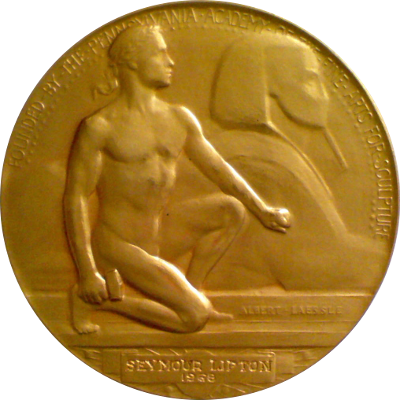
The obverse bears a bust of George Widener, a prominent Philadelphia financier, horse breeder, and director of the Pennsylvania Academy of the Fine Arts who died in 1912 on the Titanic. Around, GEORGE - D - WIDENER - MEMORIAL. The reverse bears a nude figure kneeling beside a sphinx and holding a mallet and chisel, associating the prizewinner's work with thousands of years of sculpture. Around, FOUNDED - BY - THE - PENNSYLVANIA - ACADEMY - OF - THE - FINE - ARTS - FOR - SCULPTURE. Signed ALBERT - LAESSLE.
The George D. Widener Memorial award was established in 1912 by the Pennsylvania Academy of the Fine Arts to honor one of its major benefactors. The award recognizes the "most meritorious work of Sculpture modeled by an American citizen and shown in the Annual Exhibition." Laessle himself won this medal in 1918.
The medal measures 50mm in diameter. It is struck in fine gold for the award's recipient and in bronze for general release.
The image of the golden variant shows the medal awarded to Seymour Lipton in 1968.
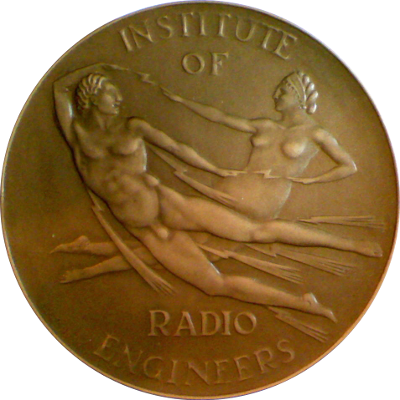
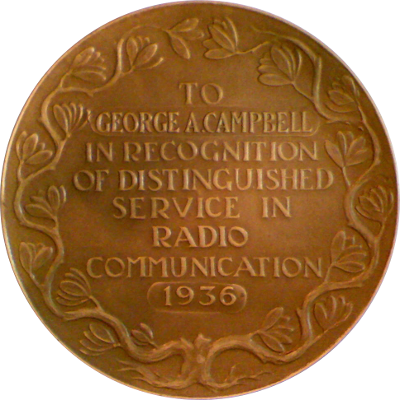
This medal's obverse bears nude male and female figures in flight, representing electromagnetism, lightning surrounding male figure and small bolts between the two figures' hands. Above and below, INSTITUTE / OF / RADIO / ENGINEERS
The medal's reverse bears decorative branches in wreath shape around dedication in center field, TO / GEORGE A. CAMPBELL / IN RECOGNITION / OF DISTRINGUISHED / SERVICE IN / RADIO / COMMUNICATION / 1936
The edge is marked with MEDALLIC ART CO. N.Y. BRONZE
The Institute of Radio Engineers was a professional organization which existed from 1912 until 1962. In 1963 it merged with the American Institute of Electrical Engineers (AIEE) to form the Institute of Electrical and Electronics Engineers (IEEE). Starting in 1917, the Institute awarded its Medal of Honor to engineers who had created useful advances in the field of radio communications. The award recipient in 1936 was Dr. George A. Campbell, a retired scientist, for his contribution to the theory of electrical networks. He invented the electric wave filter, a foundational element of modern electronic communications equipment.
The medal is still issued today under the auspices of the IEEE.
The medal measures 76mm in diameter and was struck in bronze and gold by the Medallic Art Company of New York.
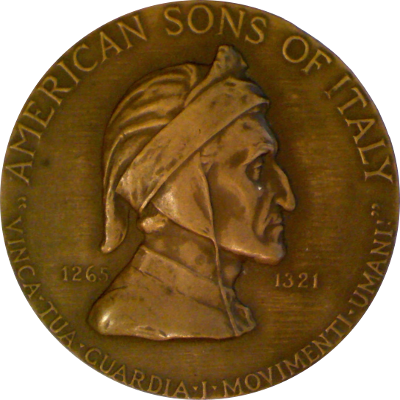
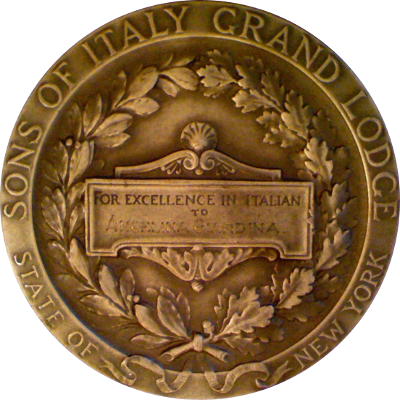
The obverse bears bust of Dante Alighieri facing right. Around top, AMERICAN SONS OF ITALY; around bottom, "VINCA · TUA · GUARDIA · I · MOVIMENTI · UMANI!"; to left and right of bust, 1265 - 1321
The reverse bears laurel and oak branches around central field. Around top, SONS OF ITALY GRAND LODGE; around bottom, STATE OF - NEW YORK; in central field, FOR EXCELLENCE IN ITALIAN / TO / ANGELINA GUARDINA
The Order of the Sons of Italy is the largest and oldest national organization for men and women of Italian heritage in the United States. It was founded on June 22, 1905 by Dr. Vincenzo Sellaro to help assimilate Italians into American society during the immigration boom of the early 20th century. In 1928 Dr. Sellaro was given the key to the City of New York in recognition of his social and medical achievements.
1921 was the 600th anniversary of Dante Alighieri's death and the medal celebrates both the poet and the Italian language. It was awarded to young students for excellence in Italian. The Italian quote on the obverse is from the 33rd Canto of Dante's Divine Comedy and translates to:
"May your protection curb his mortal passions!"
The medal measures 68.9mm in diameter and was struck by the Medallic Art Company of New York.
References: MACo 1921-080
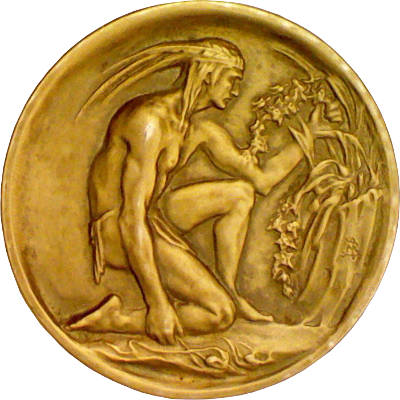
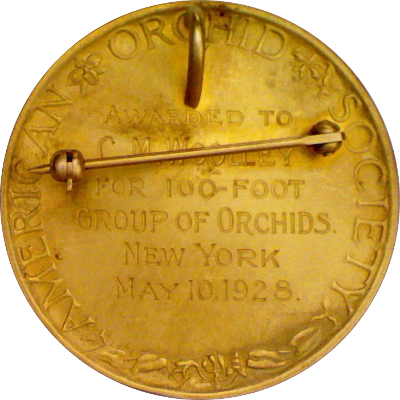
This medal's obverse bears kneeling Native American brave facing right, holding risp of orchids growing from raised ground on right. In ground at right, signed (BA monogram).
On the medal's reverse, around circumference, AMERICAN (flower) ORCHID (flower) SOCIETY; in center field, AWARDED TO / C. M. WOOLEY / FOR 100-FOOT / GROUP OF ORCHIDS. / NEW YORK / MAY 10, 1928.
The edge is marked with MEDALLIC ART CO. N.Y. 18Kt
This is a very feminine medal in which the Native American brave seems lost in contemplation while studying the risp of orchids. He seems totally relaxed with his right arm hanging at his side, the hand closed loosely around a length of string or plant fiber. The theme conveys both the native origin of the plants and the gentle nature of the hobby of orchid cultivation. We're leaving aside for the moment the fiercely competitive aspect of any organized club activity.
This beautiful medal was converted into a brooch or a pendant at some point in the past by soldering a clasp and a loop to its reverse. We can be grateful that the obverse was left alone and that the alterations appear to have been performed by a skilled jeweler.
The circular medal measures 41.4mm in diameter and was struck in 18Kt gold by the Medallic Art Company of New York.
References: Marqusee 9

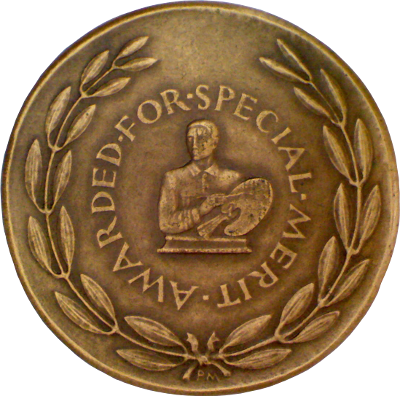
The obverse bears Art Deco image of Bellerophon with lyre riding winged pegasus above sun. Around, ART DIRECTORS CLUB / INCORPORATED 1920.
The reverse bears painter with palette and brush in center. Around center, AWARDED FOR SPECIAL MERIT. Around edge, laurel wreath with (PM monogram) at bottom.
The edge is marked MEDALLIC ART CO. N.Y.
Louis Pedlar founded the Art Directors' Club of New York in 1920 in response to the uncertain relationship between advertising art and fine art. Pedlar assembled a group of art buyers, art department managers and layout artists to ponder whether advertising art could be judged by the same stringent standards as fine art.
Obviously the answer was "yes" because Paul Manship was asked to create a medal to be used as an award. Awards were given annually in the areas of black-and-white illustration, color illustration, oil painting, and poster art, though not always in all areas.
An article published in Printers' Ink Monthly outlines the process that was used:
"All mediums were given consideration; black-and-white, flat color, oil painting and decorative design. A rigid standard of selection was enforced, and the 300 pictures shown, selected from many thousands submitted, represented the best there is in advertiding design.
Both the organization and the award still exist but the medal was replaced by a modern cube in the 1970's.
The medal measures 54mm (2 1/8in) in diameter and were manufactured by the Medallic Art Company of New York.
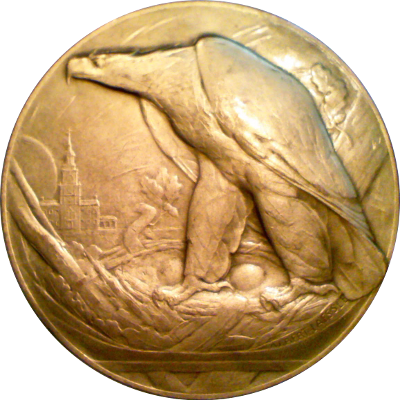
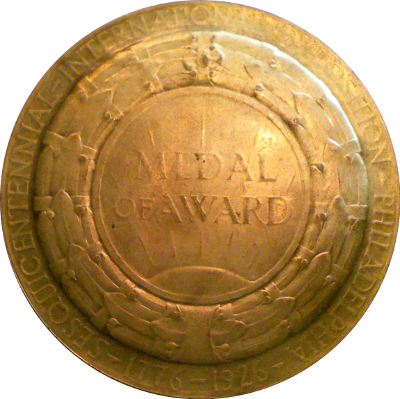
Leassle designed this medal for an exposition on his "home turf" in Philadelphia. The obverse bears an eagle standing guard over nest with two eggs in front of Independence Hall and rising sun. Signature ALBERT LAESSLE. The reverse bears a laurel wreath around central field with rising sun and legend MEDAL OF AWARD. Around, SESQUICENTENNIAL - INTERNATIONAL - EXPOSITION - PHILADELPHIA / 1776 - 1926.
The medal measures 76mm in diameter and was struck by Baily Banks & Biddle Co., Philadelphia.
Laessle himself won his design in gold at this exposition.
References: Marqusee 235
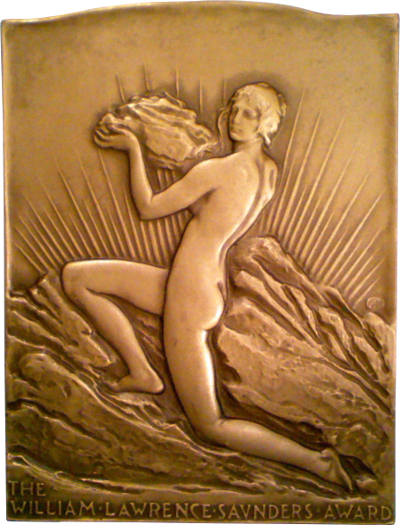
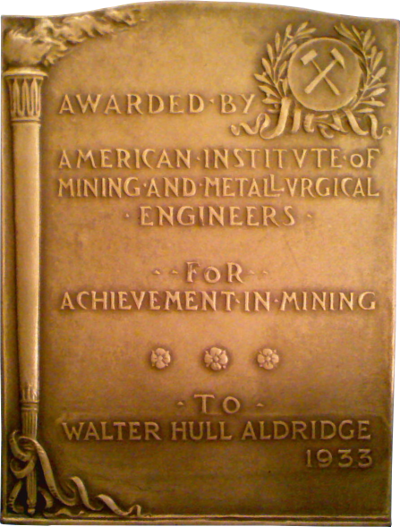
The obverse bears nude female figure representing Earth kneeling on rocky surface holding up large rock in offering; sun rays on horizon behind. At bottom, THE / WILLLIAM LAWRENCE SAVNDERS AWARD
The reverse bears a burning torch along left edge and the seal of the American Institute of Mining and Metallurgical Engineers in the top right corner. Inscription reads AWARDED BY / AMERICAN INSTITVTE OF / MINING AND METALLVRGICAL / ENGINEERS / FOR / ACHIEVEMENT IN MINING / (rosette) (rosette) (rosette) / TO / WALTER HULL ALDRIDGE / 1933
The edge is hallmarked MEDALLIC ART CO.N.Y.
William Lawrence Saunders was the 1915 president of the American Institute of Mining, Metallurgical, and Petroleum Engineers, a chairman of Ingersoll Rand Company, and deputy chairman of the Federal Reserve Bank of New York. This award, known today as the William Lawrence Saunders Gold Medal, was established in 1927 and recognizes achievement in mining other than coal. Anthony de Francisci designed the award medal in 1927. A plaster cast is in the collection of the Smithsonian American Art Museum.
Walter Hull Aldridge (1867-1959) was an accomplished mining engineer and, in addition to this very prestigious award, received the coveted John Fritz Medal (1950) regarded as the highest honor an engineer may attain.
The plaque measures 67mm x 89mm and was struck in bronze by the Medallic Art Company of New York.
References: MACo 1926-009

This uniface medal's bears scroll, inkwell and masks of Comedy and Tragedy. Around, STUDIO OF ACTING, NEW YORK; under masks, PERCY HAMMOND / MEDAL / (CB monogram).
The award was named for Cadiz, Ohio-born Percy Hammond. After starting a journalistic career in Chicago he became an immensely influential theater critic for the New York Herald Tribune. In 1927 he published his only book, a collection of essays on theater titled But - Is It Art? Another anthology of his best writings was published under the title This Atom in the Audience. Hammond died after a brief illness on April 25th, 1936 in New York City.
The medal measures 51.5mm in diameter and was struck in bronze by the Medallic Art Company of New York.
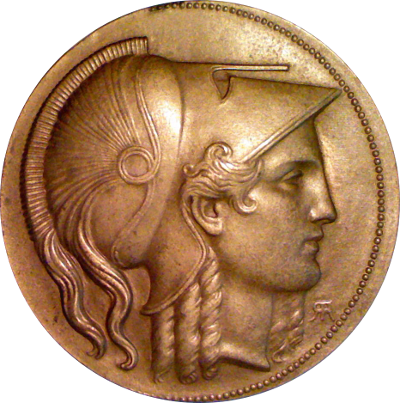
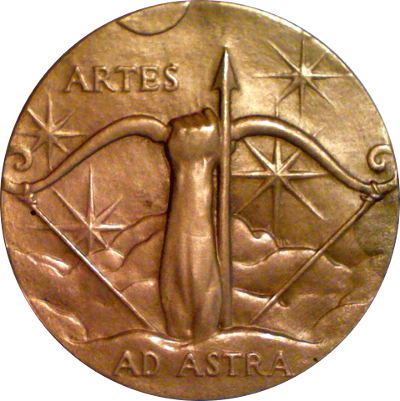
The medal's obverse bears helmeted head of Minerva (r.) within assymetrical beaded border. Signed below Minerva's chin, (RA monogram).
The reverse bears an arm aiming a bow and arrow upward through the clouds. Above and below arm, ARTES / AD ASTRA (The arts towards the stars).
The medal is edge marked with MEDALLIC ART CO.N.Y.
This award was established by famous architect Cass Gilbert to be awarded by the Council of the National Academy to persons here or abroad who have made significant contributions to the advacement of the arts. Aitken designed the medal in 1929 but by 1975, the Academy's 150th anniversary, it had only been awarded seven times.
The medal measures 56.7mm (2.25") in diameter and was struck in bronze by the Medallic Art Company of New York. The mintage is not known.
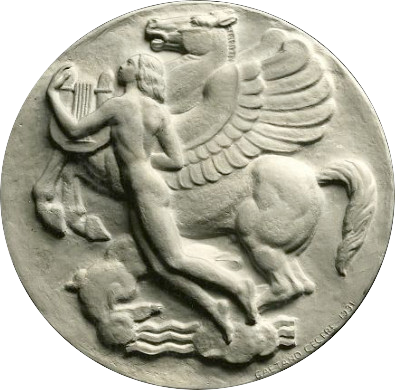
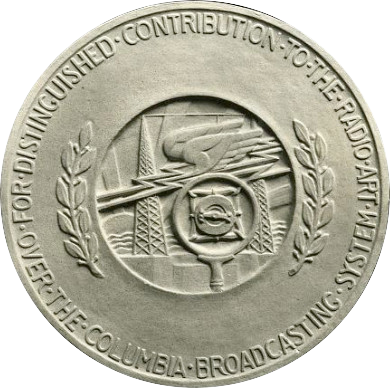
The obverse bears a nude with lyre in front of Pegasus; signed GAETANO CECERE 1931. The reverse bears a grouping of transmission towers, lightning bolts, and wings, surrounded by wreathes and text in concentric circles. Legend reads FOR DISTINGUISHED CONTRIBUTION TO THE RADIO ART | OVER THE COLUMBIA BROADCASTING SYSTEM. The medal's diameter is 102mm or 4in.
The medal was awarded "for Distinguished Contribution to Radio" and by 1934 only six people had received it. They were: Colonel Charles Lindbergh, Sir John A. Reith, director general of the BBC, Leopold Stokowski, conductor of the Philadelphia Orchestra, Amelia Earhart, Nino Martini, Metropolitan Opera tenor, and Rear Admiral Richard E. Byrd, Antarctic explorer.
The medal is part of many museum collections, including the Smithsonian Institute, the Metropolitan Museum of Art, and the Cornell University Library, which has a beautiful image online.
The original images can be found on the website of the Smithsonian Institute.
References: Marqusee 104
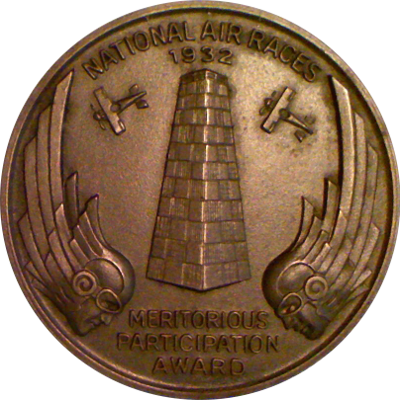
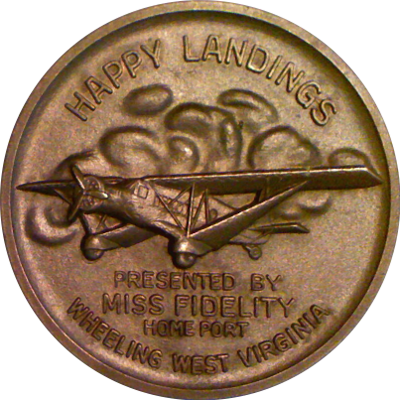
The obverse bears a central pylon flanked by two aircraft and two Art Deco-style winged heads. Above, NATIONAL AIR RACES / 1932; below, MERITORIOUS / PARTICIPATION / AWARD.
The reverse shows a Bellanca P200 plane in front of clouds. Above, HAPPY LANDINGS; below, PRESENTED BY / MISS FIDELITY / HOME PORT / WHEELINGS WEST VIRGINIA.
The Bellanca P200 airbus was built for $45,000 for the Fidelity Investment Company of Wheeling, West Virginia. It was one of nine built by the Bellanca Aircraft Corporation of New Castle, Delaware, and was one of the most advanced and economic commercial airplanes of its day. In 1934 federal regulations prohibited single engine transports on United States airlines, virtually eliminating the airbus' market. In Canada the P200 and its successor, the P300, were used into the 1970's to ferry ore, supplies and the occasional passenger from and to remote northern mining sites.
One of these small medals was awarded to every participant of the 1932 National Air Races held in Cleveland. The winged heads on this medal are reminiscent of Oskar Hansen's better known Olympiad of the Air medal from two years earlier.
The medal measures 36.7mm (1.5in) in diameter and was struck in bronze in an unknown mintage.
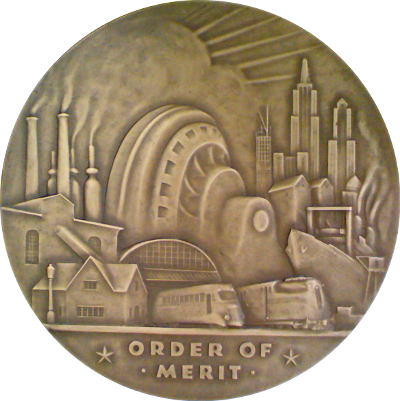
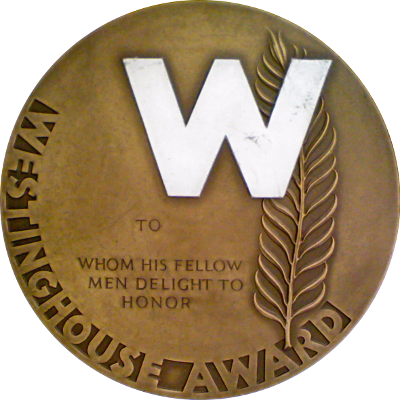
The obverse bears art deco city scape with factories and skyscrapers surrounding a giant generator building; clouds and sun rays above; house and train engines below. In exergue, * ORDER OF * / MERIT
The reverse bears large silver letter W over palm frond. Around, WESTINGHOUSE AWARD; in lower half, TO / (blank) / WHOM HIS FELLOW / MEN DELIGHT TO / HONOR
The Westinghouse Order of Merit was awarded by Westinghouse Electric Corporation as its highest form of employee recognition. Both management and technical employees were eligible to receive the award.
The medallion has a diameter of 101mm. It was struck in bronze by the Medallic Art Company of New York. The mintage is not reported.
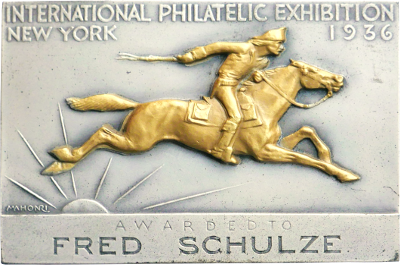
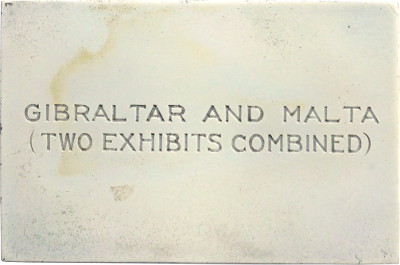

This uniface medal's obverse bears a horse in full gallop with rider bent over horse's neck and whip in hand. An Art Deco sun on the horizon on the left. Above, INTERNATIONAL PHILATELIC EXHIBITION / NEW YORK - 1936; signed near sun, MAHONRI. In empty field below, AWARDED TO.
The bottom edge is marked MEDALLIC ART CO NY for the bronze medal and MEDALLIC ART CO NY - FINE GOLD for the medal of unknown composition.
The medal was produced in both bronze and silver. Silver copies are held by the Cleveland Museum of Art and the American Numismatic Society (1936.130.1). The medals were awarded to exhibitors.
This medal measures 84mm x 55mm and was produced by the Medallic Art Company of New York in both bronze and silver. The mintage is not known.
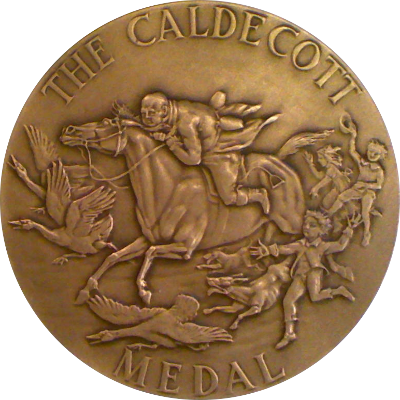

The obverse shows Gilpin astride a runaway horse, surrounded by geese, dogs, and children. Above and below, THE CALDECOTT / MEDAL
The reverse bears bald man carrying a bird pie, being attacked by three birds. Around top, FOR THE MOST DISTINGUISHED AMERICAN / PICTURE BOOK FOR CHILDREN; four lines around bottom, AWARDED ANNUALLY BY / THE CHILDREN'S AND SCHOOL / LIBRARIANS SECTIONS OF THE / AMERICAN LIBRARY ASSOCIATION; signed to right of figure, (RC monogram)
The Randolph Caldecott Medal annually recognizes the preceding year's "most distinguished American picture book for children", beginning with 1937 publications. It is awarded to the illustrator by the Association for Library Service to Children (ALSC), a division of the American Library Association.
The scene on the obverse is based on Randolph Caldecott's 1878 front cover illustration for "The Diverting History of John Gilpin", itself based on a 1782 poem by William Cowper. The reverse is based on "Four and twenty blackbirds baked in a pie," one of Caldecott's illustrations for the nursery rhyme "Sing a Song of Sixpence."
This bronze medal has a diameter of 58mm and was struck by the Medallic Art Company of New York.
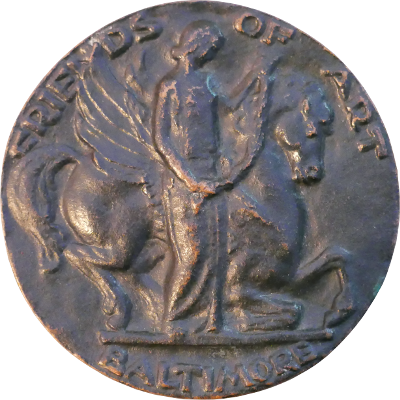

The obverse bears standing female figure in front of winged horse Pegasus, both facing right. Around, FRIENDS OF ART / BALTIMORE
The reverse reads THE / WILSON / LEVERING / SMITH / MEMORIAL / AWARD TO / (cartouche). The cartouche is engraved with MERVIN JULES / PRINTS AND WATER COLORS
The Baltimore Friends of Art was founded in 1919 and later merged with the Municipal Art Society. This medal was awarded at the annual exhibition of Maryland artists held at the Baltimore Museum of Art. Mervin Jules won this award in both 1939 and 1941.
The cast medal measures 100mm in diameter. It is not known how many were made.
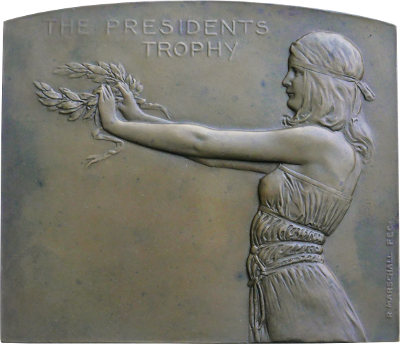
The uniface plaque bears a young woman, facing left, holding out a victor's wreath. Above, PRESIDENTS / TROPHY; signed along lower right edge, R MARSCHALL FEC.
Marschall's basic plaque design proved to be very popular as an award. The Medallic Art Company created four differently sized versions of the plaque and just changed the inscriptions for different customers. I do not know the organization that awarded this "President's Trophy" and would welcome any additional information.
This piece measures 164mm x 140mm.
References: MACo 1940-019
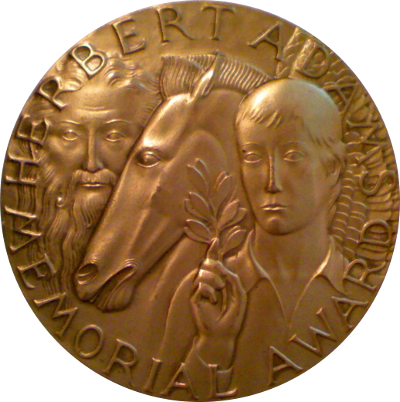
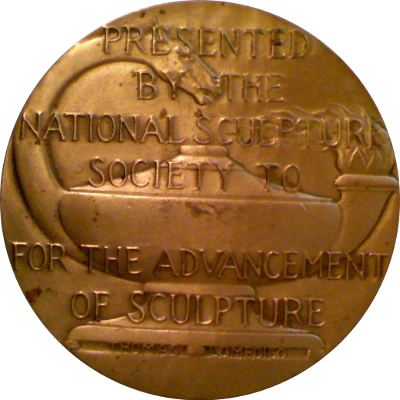
The obverse bears the figures of a bearded old man, Pegasus, and a young man, who holds laurel in his proper right hand. The horse Pegasus represents Genius and the old man represents Wisdom. Around, HERBERT ADAMS / MEMORIAL AWARD. The reverse of the medal shows a lamp with a flame. The lamp's handle is a horse's neck and head. Across, PRESENTED / BY THE / NATIONAL SCULPTURE / SOCIETY TO / FOR THE ADVANCEMENT / OF SCULPTURE / THOMAS LOMEDICO
Lo Medico's design won first prize in the National Sculpture Society's competition for this medal in 1946. The medal is awarded annually to an individual who has advanced American sculpture.
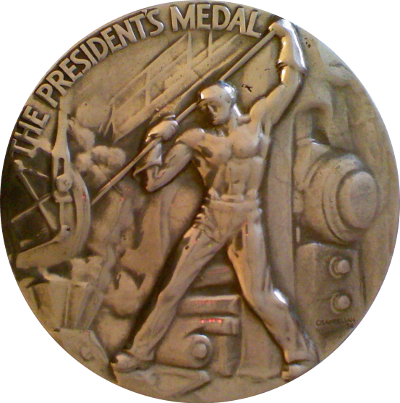
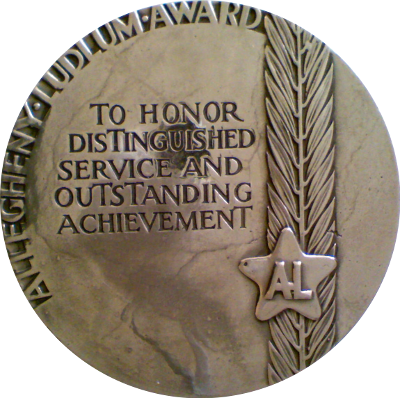
Chambellan designed this medal for the Allegheny Ludlum Steel company that was formed in 1938 by the merger of the Allegheny Steel Company of Brackenridge, Pennsylvania and the Ludlum Steel Company of Watervliet, New York. In 1996 it became part of Allegheny Technologies. I found a newspaper reference to the medal being awarded in 1946, which dates it to the period between 1938 and 1946. Dick Johnson dates it to 1946.
The obverse bears a bare chested steel worker wearing insulated gloves wielding a long rod, with machinery in the background. Above, THE PRESIDENT'S MEDAL; signed CHAMBELLAN / SC. The reverse bears a branch and a star with the embedded letters A-L. Around, ALLEGHENY LUDLUM AWARD; dedication in center, TO HONOR DISTINGUISHED SERVICE AND OUTSTANDING ACHIEVEMENT.
This bronze medal has a diameter of 98mm (3 7/8in). It was probably struck by the Medallic Art Company but it does not bear a maker's mark, maybe due to the chrome plating.
References: MACo 1946-013
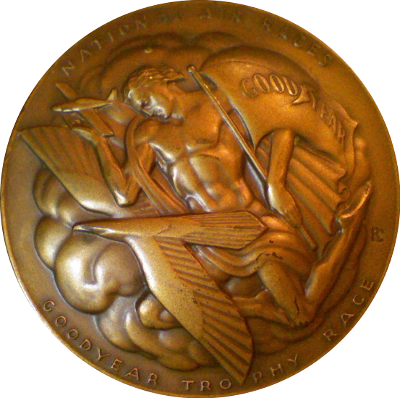
The medal bears a flying eagle and nude man, holding GOODYEAR banner in eft and small plane in right, over swirling clouds. Above, NATIONAL AIR RACES; below, GOODYEAR TROPHY RACE; to right, signed (monogram PRC).
Chambellan did a lot of work for Goodyear. In addition to this trophy medallion, he designed several medals for Goodyear dealers and business partners.
It is not known when Chambellan designed this medal but it was first awarded in 1947. The Goodyear Trophy Race was a newly introduced event at the Cleveland National Air Races in 1947. At the end of the first post-war Cleveland National Air Races, a lot of specators had walked out because the ex-military airplanes were too similar and as a consequence the races were not as exciting to watch as the pre-war competitions that had sported highly individual racing airplanes. The organizers resurrected an old idea for small, low-powered, custom-built "midget" airplanes that could race around a smaller track closer to the spectators. The Goodyear Trophy Race was born.
There is no information about the medal itself that I could locate and I would appreciate any help. My copy is mounted an a 268mm x 200mm (10.5in x 7 7/8in) wooden board with a name plate reading ROBERT S. HOPKINS / RACE PLANE BUILDER / 1947.
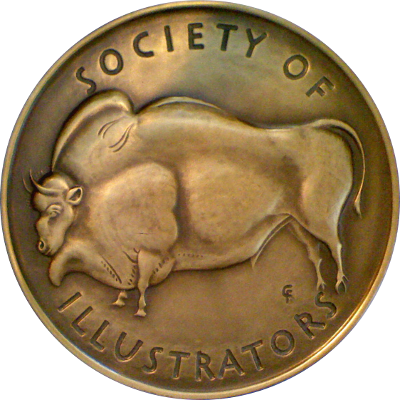
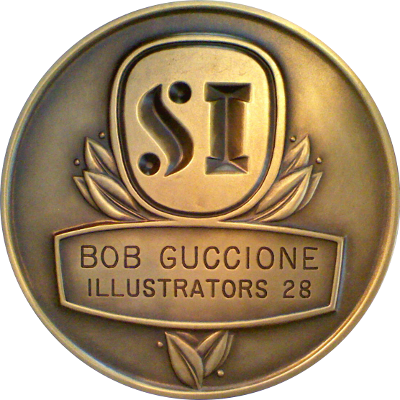
This medal's obverse bears Bison facing left. Above and below, SOCIETY OF / ILLUSTRATORS; signed with combined (CF monogram)
The reverse bears deeply incuse SI in raised field above panel inscribed with recipient's name: BOB GUCCIONE / ILLUSTRATORS 28
The edge is marked © 1984 MEDALLIC ART CO. - DANBURY, CT. - BRONZE
The Bison shown on the face of this medal is adapted from the wall painting in the cave of the Font-de-Gaume at Les Eyzies in Southern France and was one of man's earlier art efforts. The species of Bison, now almost extinct, differs somewhat from the North American form, with a rather small head and not so much fur over the head, neck and shoulders.
The medal was awarded to Bob Guccione, the founder of Penthouse Magazine, and a painter and illustrator. While he is best known for founding Penthouse Magazine, he originally only started the magazine to subsidize his career as a well-respected visual artist.
The circular medal which was designed by Robert Foster and sculpted by Mario Cooper measures 76mm in diameter and was struck in bronze by the Medallic Art Company.
Many thanks to Richard Berenson, a past president of the Society iof Illustrators, who sent me most of the information about this medal.
Amy Angell Collier Montague Medal1950
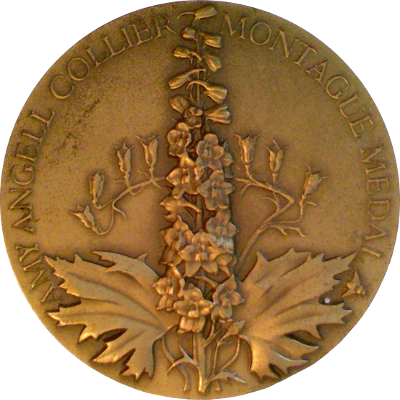

This medal's obverse bears hyacinth stem with two large leaves. Around, AMY ANGELL COLLIER MONTAGUE MEDAL; signed around lower right, G K LATHROP
The reverse bears flower in center panel, surrounded by four dolphins. Around, THE GARDEN CLUB OF AMERICA - · CIVIC ACHIEVEMENT AWARD · engraved to LOUISE BUSH-BROWN / 1955
The edge is marked MEDALLIC ART CO. N.Y. / BRONZE
The Garden Club of America was founded in 1913 to provide an umbrella for the many gardening organizations that were active at the time. Among many other activities, it awards several medals for achievement in different areas. The Amy Angell Collier Montague Medal is awarded for outstanding civic achievement. This particular piece was awarded in 1955 to Mrs. James Bush-Brown for originating the Garden Association of Philadelphia, starting with flower boxes for the flowerless in low rent housing areas.
With this medal Gertrude K. Lathrop demonstrated once again her marvelous skill at depicting plant and animal life in medallic form.
The circular medal measures 76mm in diameter and was struck in bronze by the Medallic Art Company of New York. No mintage is reported.
References: MACo 1950-015
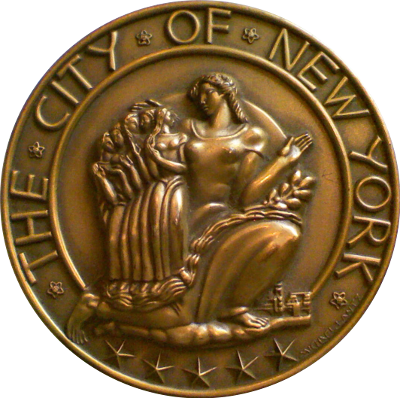
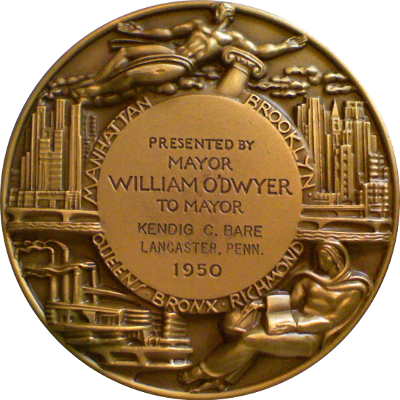
The obverse bears Art Deco style allegory depicting a kneeling female figure (representing the city) with five smaller figures (representing the five boroughs) standing on her extended leg. Around, THE CITY OF NEW YORK / * * * * *; signed along edge at 5:00 position: MICHAEL LANTZ.
The reverse bears flying male figure at top with skyscrapers below to either side; at bottom right, a reclining female figure holding book; at bottom left, a factory with smokestacks; at center, inscribed field surrounded by the names of the five boroughs: MANHATTAN BROOKLYN QUEENS BRONX RICHMOND. This piece contains inscription: PRESENTED BY / MAYOR / WILLIAM O'DWYER / TO MAYOR / KENDIG C. BARE / LANCASTER. PENN. / 1950
This medal is the highest award conferred upon civilians by the City of New York. The medal is presented by the Mayor to those individuals who have demonstrated, "exceptional citizenship and outstanding achievement."
The recipients come from a wide range of backgrounds, including ordinary citizens, foreign dignitaries, athletes, and film stars. The recipient of this particular piece was Kendig C. Bare, the mayor of Lancaster, Pennsylvania. He was mayor from 1950 to 1958 and served in the Korean War in 1950/1951. This particular piece seems to be one of the earliest because the medal was only designed in 1950. It is based on Michael Lantz's Golden Anniversary medal from 1948 and reworked into this design in 1950.
This medal measures 70mm in diameter and was struck in bronze by the Medallic Art Company of New York.
References: Marqusee 236
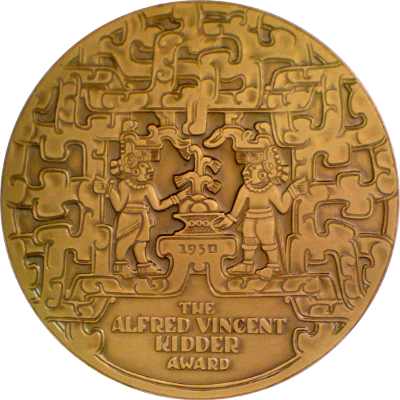
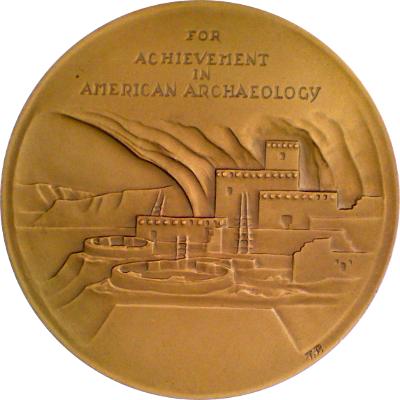
The medal's obverse bears a classic Mayan motif of two priests at an altar. Incuse on altar, 1950; In exergue, THE / ALFRED VINCENT / KIDDER / AWARD
The reverse shows a Southwestern pueblo under cliff or in cave, maybe Mesa Verde. Above, FOR / ACHIEVEMENT / IN / AMERICAN ARCHAEOLOGY; signed T.P. along rim in lower right.
The edge is marked at 12:00, ROBBINS CO. ATTLEBORO / GENUINE BRONZE
Alfred Vincent Kidder (October 29, 1885 � June 11, 1963) was an American archaeologist considered the foremost of the southwestern United States and Mesoamerica during the first half of the 20th century. He saw a disciplined system of archaeological techniques as a means to extend the principles of anthropology into the prehistoric past and so was the originator of the first comprehensive, systematic approach to North American archaeology.
Established in 1950, the Alfred Vincent Kidder Award for Eminence in the Field of American Archaeology was given every three years to an outstanding archaeologist specializing in the archaeology of the Americas. The award has been given alternately to specialists in Mesoamerican archaeology and the archaeology of the Southwestern region &emdash; areas that were both central to the pioneering and exemplary work of A. V. Kidder.
This award, presented by the AAA but selected by the Archaeology Division of AAA, is now given every two years.
The medal expresses the two different archeaological areas of interest through the imagery on the two sides, both of which were designed by Tatiana Proskouriakoff (1909-1985). She not only designed the medal but was also the award's fifth recipient. The Mayan motif on the obverse represents the Mesoamerican area, whereas the pueblo scene on the reverse represents the Northamerican Southwest.
The medal measures 76mm (3in) in diameter and was struck in bronze by the Robbins Company of Attleboro, Massachusetts.
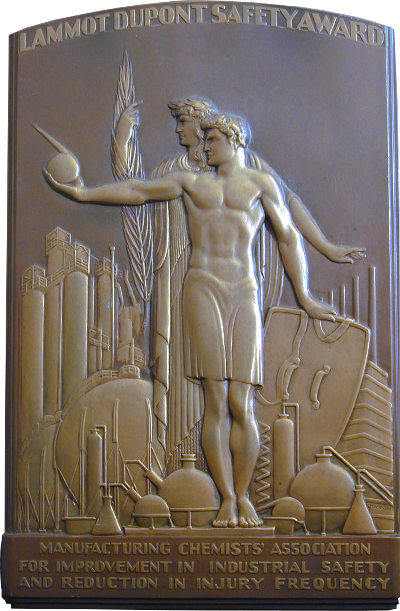
Listing this plaque under the "Medals" rather than the "Other Works" section is a bit of a stretch. It is mounted on a large mahogany board and intended to be displayed on a wall. I put it here because it is a bronze bas-relief work and can be seen as a medallic object even though - at 255mm x 380mm - it is very much on the large side.
The plaque shows two conjoined male figures wearing laurels, figure in back holding a palm frond, figure in front holding flask in one hand and shield in other; all kinds of chemical laboratory equipment arrayed at their feet and large chemical industry installations behind them. Above, LAMMOT DUPONT SAFETY AWARD; below, MANUFACTRING CHEMISTS' ASSOCIATION / FOR IMPROVEMENT IN INDUSTRIAL SAFETY / AND REDUCTION IN INJURY FREQUENCY
Elsa Atson of the Chemical Heritage Foundation graciously agreed to do some research on my behalf and unearthed the following information in the MCA minutes:
During his long association with the MCA, Lammot du Pont was keenly interested in chemical plant safety. It was at his instigation that the Association's safety activities began, and he was responsible for the establishment of the monthly injury reporting service introduced in 1946.
His interest continued after retirement, and he offered to finance annual awards to member companies for injury frequency rate reductions. The Board of Directors accepted the offer in April, 1950, and the first awards were made at the Association's annual meeting in 1952.
The prestige associated with the Lammot du Pont Safety Award makes it one of the most coveted of all industry awards. Undoubtedly, efforts to win it have contributed to the reduction of the overall member company injury frequency rate.
Based on this information, Rene Chambellan probably started working on this design in 1950 but I have dated the plaque with the award's inaugural year. This instance of the plaque was awarded to the SUNOLIN CHEMICAL COMPANY in 1979.
Many thanks to Renaissance Man Antiques for granting me the use of the picture.
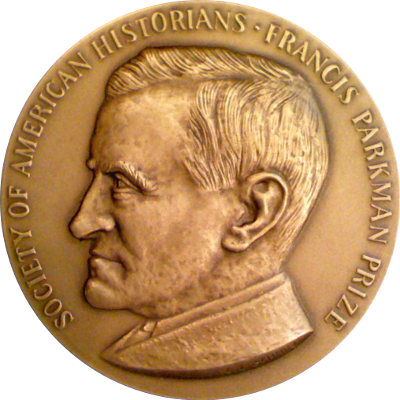
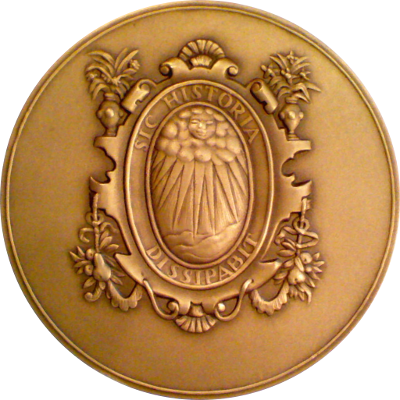
The medal's obverse bears bust of Francis Parkman, l. Around, SOCIETY OF AMERICAN HISTORIANS ˙ FRANCIS PARKMAN PRIZE; signed on truncation, C L SCHMITZ
The medal's reverse bears the Society's seal with motto SIC HISTORIA / DISSIPABIT
The edge bears maker's mark MEDALLIC ART CO NY BRONZE
The Society of American Historians' Francis Parkman Prize is awarded annually for the best nonfiction work of history on an American theme published the previous year. The prize, which carries an award of $2000, is named for Francis Parkman, whose monumental work, France and England in North America (7 vols., Boston: Little, Brown, 1865-92), was widely praised for its literary elegance as well as its historical importance.
This medal measures 70mm in diameter and was struck in bronze by the Medallic Art Company of New York.
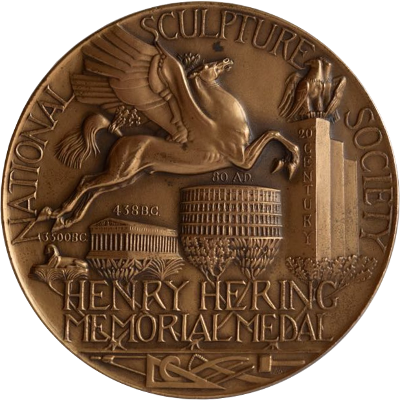

This medal's obverse bears Pegasus in flight above buildings representing historical landmarks in architecture; from left to right, the Sphinx, the Parthenon, the Coliseum, and skyscrapers with two eagles perched on top. The buildings rest on overlapping branches growing from architects' and sculptors' tools in exergue. Around top, NATIONAL - SCULPTURE - SOCIETY; over Sphinx, 3500 B.C.; over Parthenon, 438 B.C., over Coliseum, 80 A.D.; on sky scraper, 20 / CENTURY; above exergue, HENRY HERING / MEMORIAL MEDAL
The reverse bears conjoined eagles, one with wings spread, both perching on plinth; oak branches on both sides. At top, LET YOUR LIGHT SHINE BEFORE MEN / MATT 5:16; across, AWARDED AS A MARK OF DISTINCTION / FOR OUTSTANDING COOPERATION / BETWEEN ARCHITECT AND SCULPTOR; signed in exergue to left and right of plinth, ALBINO - MANCA
The National Sculpture Society's Henry Hering Memorial Award (or Henry Hering Art and Architecture Award as it is now called) was created in 1959 and is awarded for excellence in an architectural project in which the architect collaborated with the sculptor and owner of a site. The medal is not given annually; it is awarded when the circumstance arises. Originally, there were three categories: regligious, monumental, and commercial. The jury is composed of three sculptors and two architects.
The award is named for Henry Hering (1874-1949), a brilliant architectural sculptor who had a studio in New York but whose most famous works are mainly located in the mid-west.
One interesting anecdote about Hering involves a plane crash in 1945. A military B-25 had crashed into the Empire State Building. While most of the wreckage had either embedded itself in the building or fallen to the ground, one engine continued on its way for several blocks and finally ended its voyage in Henry Hering's penthouse, destroying approximately $75,000 worth of work.
This particular medal was awarded for work in the religious category in 1961. The project was the Shrine of the Immaculate Conception in Washington, D.C. The recipients were Eugene F. Kennedy, Jr. of Maginnis Walsh & Kennedy (the Boston architect) and Francis Cardinal Spellman representing the Catholic Church (the owner). The same year, Paul Manship won the award in the monumental category, along with Eric Gugler of Gugler, Kimball & Husted for the American war memorial at Anzio-Nettuno in Italy.
The circular medal measures 76.6mm in diameter and was struck in bronze by the Medallic Art Company of New York. Many thanks to Lorraine Burns for the beautiful pictures and the sleuthing involved in tracking down this particular medal's detailed history.
References: MACo 1959-031
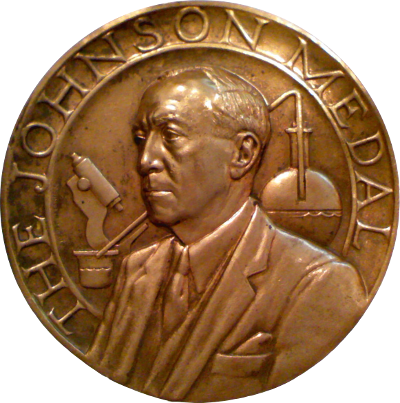

The obverse bears a scientist facing half left, between microscope, pestle, and flask. Around, THE JOHNSON MEDAL. Signed, ABRAM BELSKIE Sc. The reverse bears a female goddess with snake, goblet and plaque. Above, THE JOHNSON MEDAL. Below, FOR RESEARCH AND DEVELOPMENT.
Belskie designed this medal for Johnson & Johnson. Every year since 1960 a group of J&J's outstanding scientists from around the world are awarded the Johnson Medal, the firm's highest scientific honor. These scientists have made discoveries that led to new products in every area of J&J's businesses. In the words of Johnson and Johnson's website: "They have taken us in new directions and helped us improve the health and well being of people the world over."
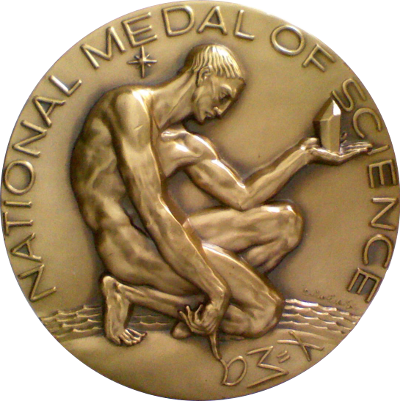
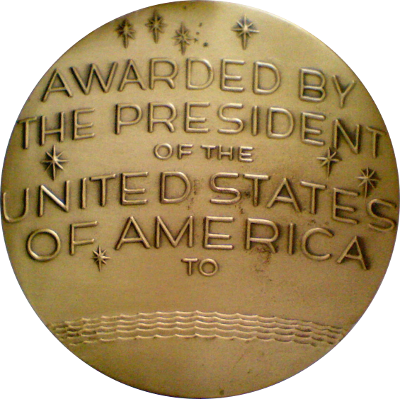
DeLue's sculpture for the NMS was based on a design by Richard H. Bolt, an associate director for planning at the National Science Foundation, who had a background in fine arts. The design was approved by President Dwight D. Eisenhower in Executive Order 10910, signed on Jan. 17, 1961.
The obverse bears Man, surrounded by Earth, sea and sky, contemplating and seeking to understand nature. The crystal in his hand symbolizes the universal order and also suggests the basic unit of living things. The formula he is sketching in the sand symbolizes scientific abstraction. Around, NATIONAL MEDAL OF SCIENCE.
The reverse bears a field of stars over abstract ocean waves. Across, AWARDED BY / THE PRESIDENT / OF THE / UNITED STATES / OF AMERICA / TO.
The medal measures 80mm in diameter and was struck by the Medallic Art Company of New York where it carries the catalog number 1960-025.
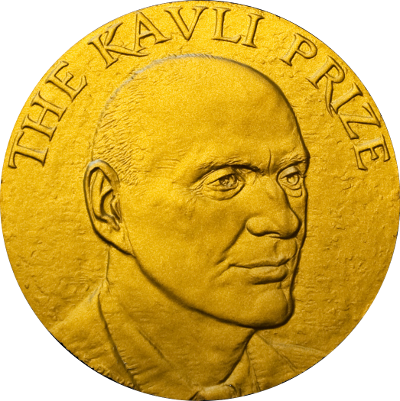
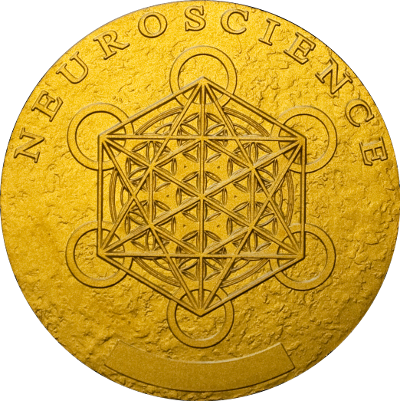
The obverse bears bust right of Fred Kavli . Above, THE KAVLI PRIZE; signed below in left, E. DAUB
The reverse display a geometric shape that cold be interpreted as a crystal lattice or a connection diagaram. Above, the field in which the prize is awarded, one of ASTROPHYSICS, NANOSCIENCE, or NEUROSCIENCE; below, recipient field.
The Kavli Prize is a partnership between The Norwegian Academy of Science and Letters, The Kavli Foundation (United States) and The Norwegian Ministry of Education and Research.
The Prize emphasizes the science of the greatest physical dimensions of space and time, the science of the smallest dimensions of systems of atoms and molecules, and the science of the most complex systems, especially living organisms. In addition to the medal and a scroll, each awardee receives $1,000,000.